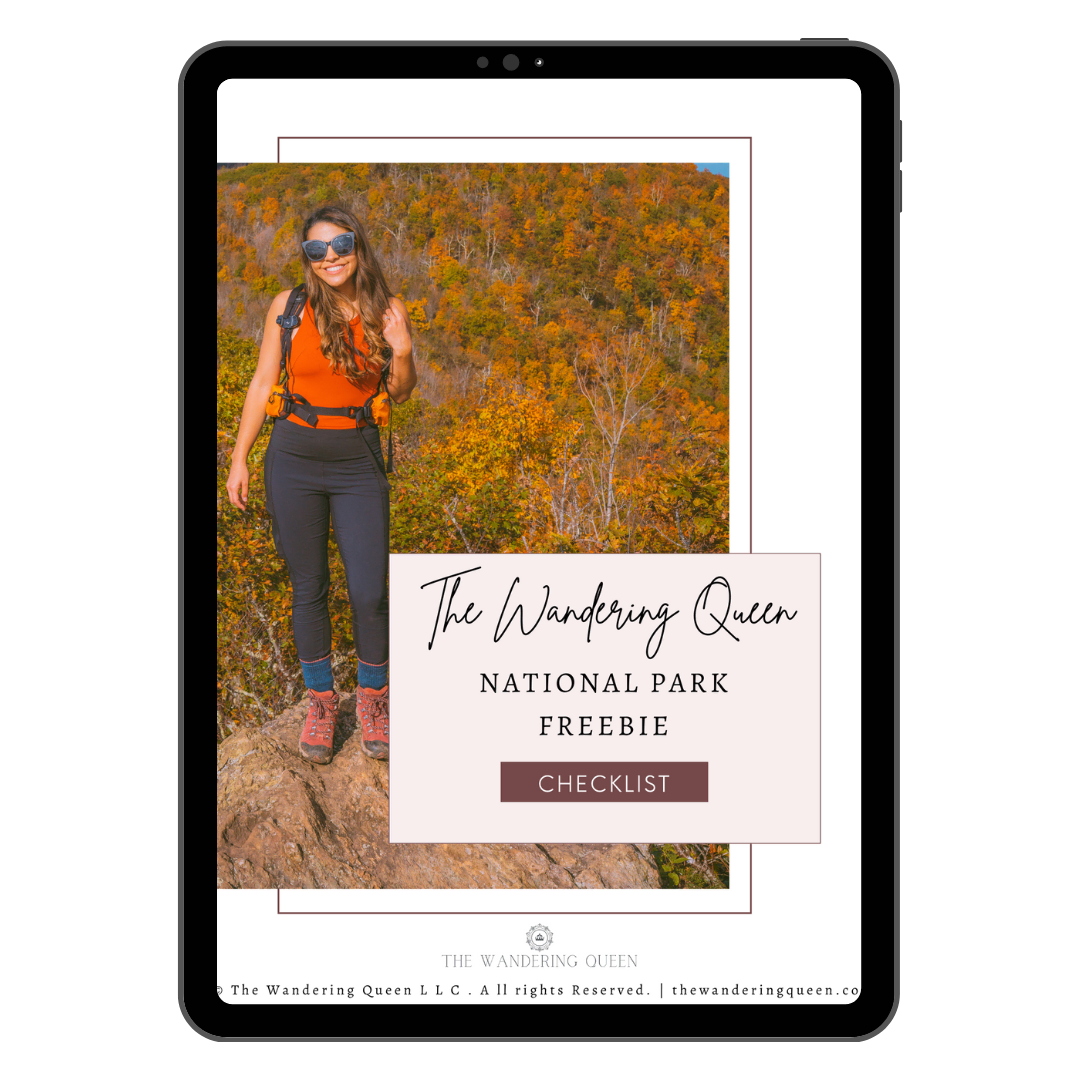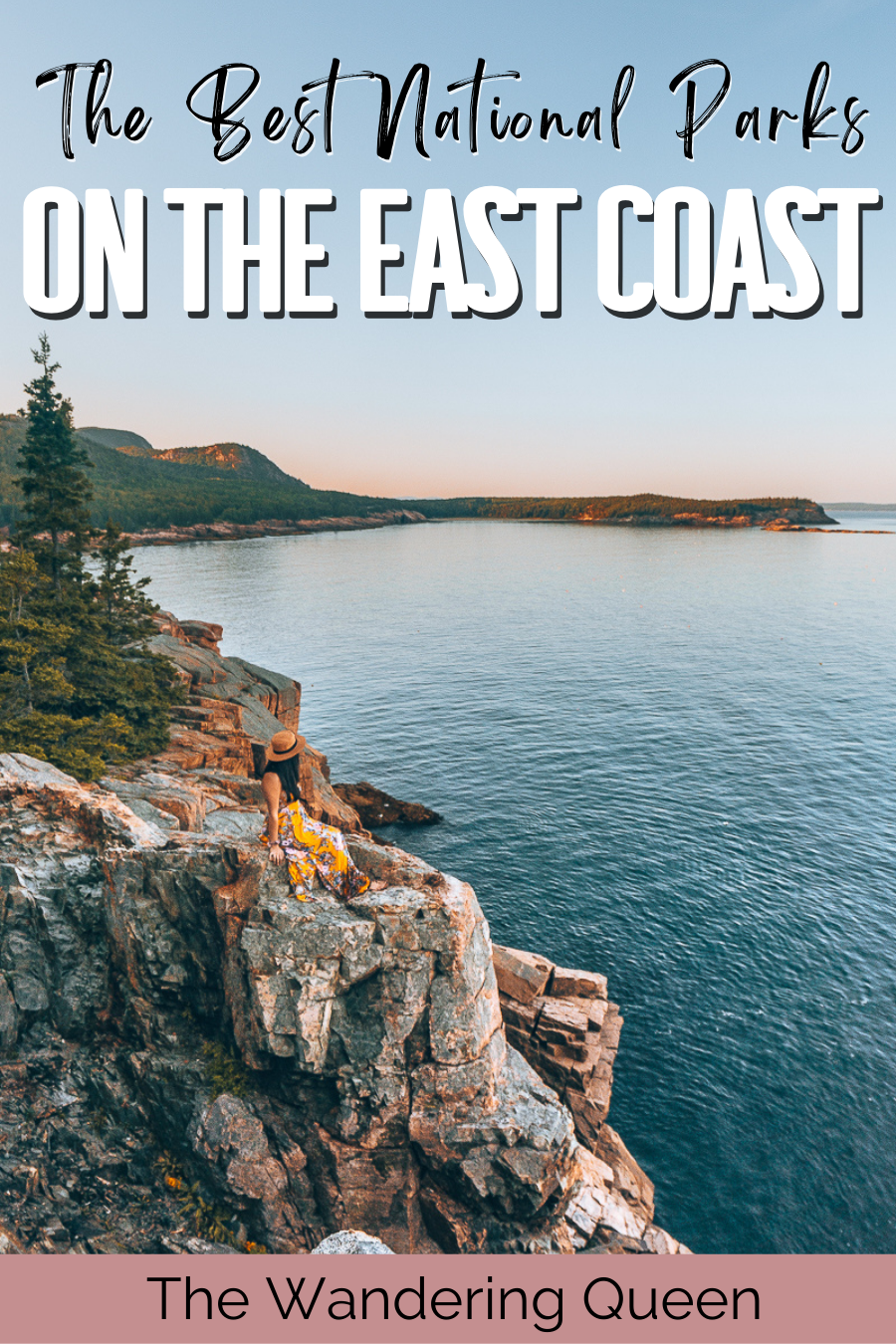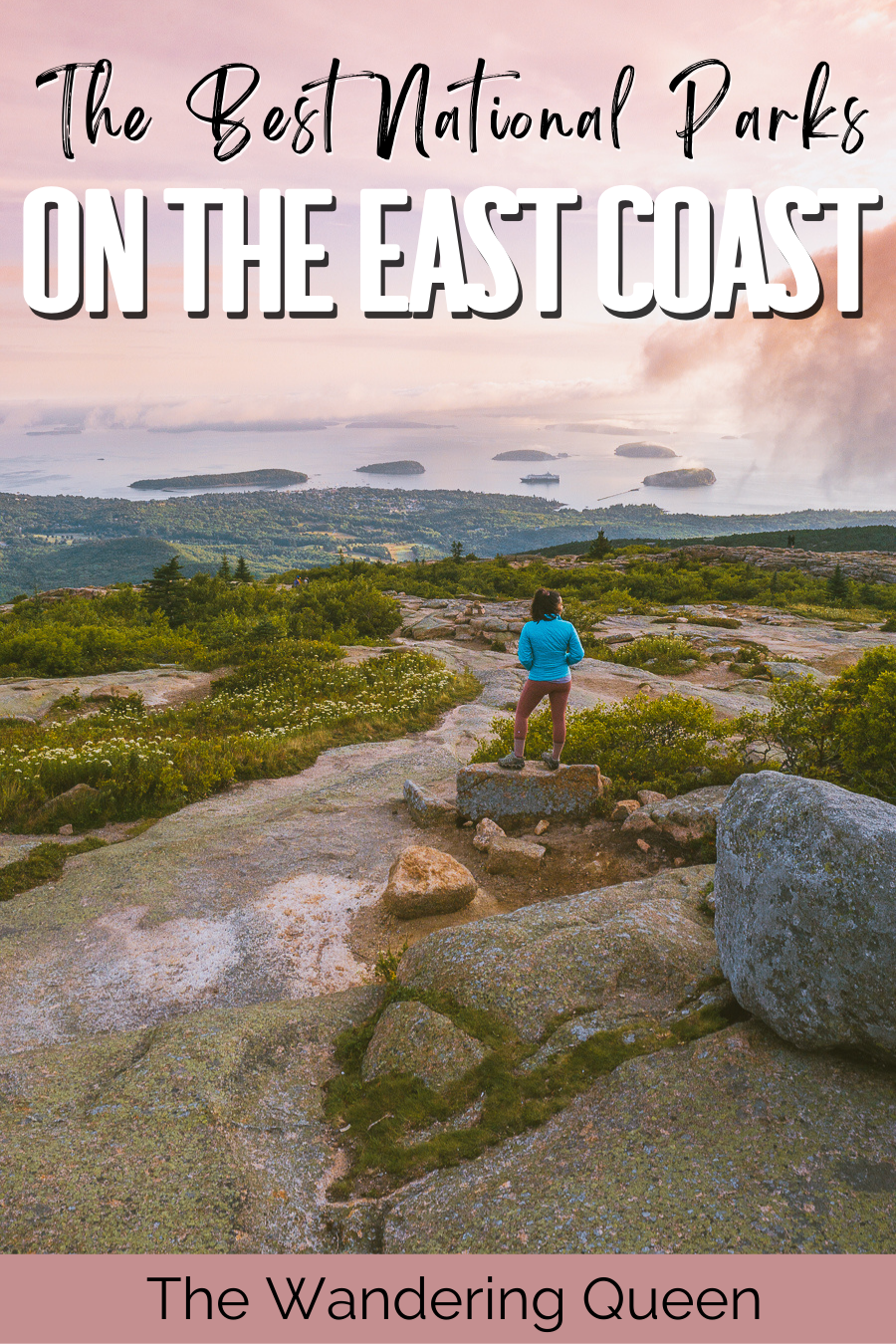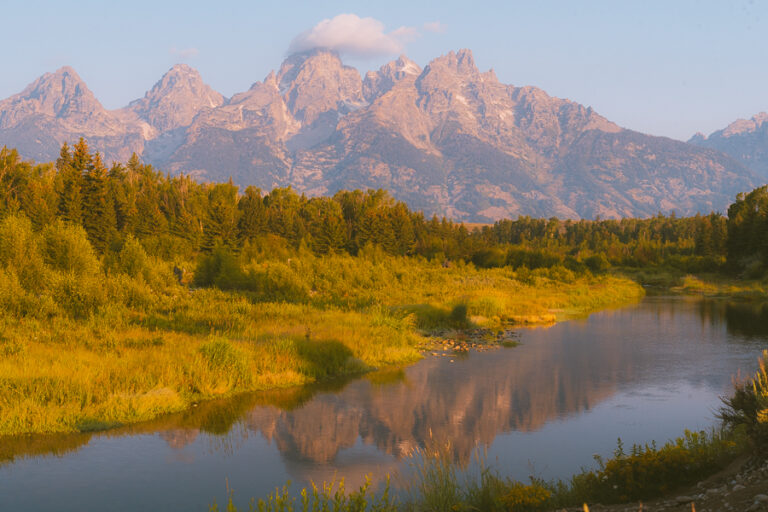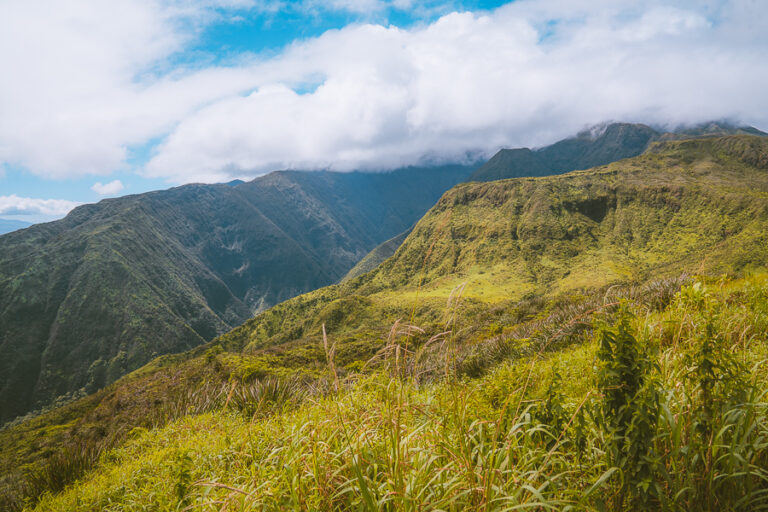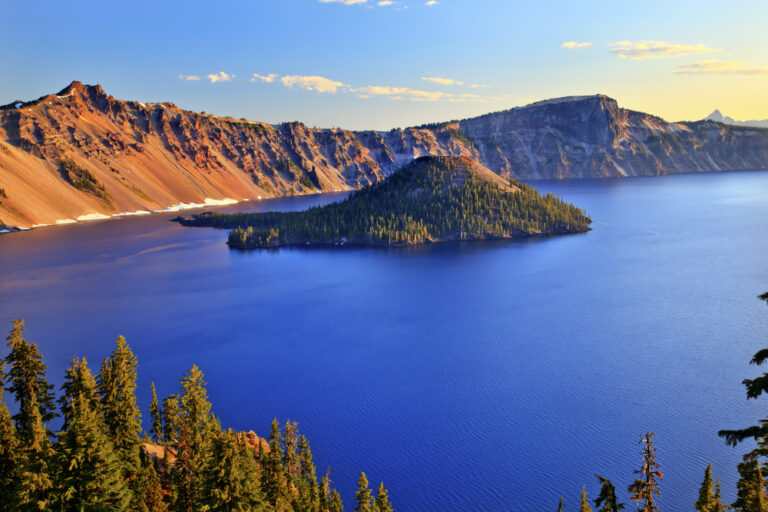The 12 Best National Parks on the East Coast – Acadia, Cuyahoga Valley & More
The East Coast is home to a wide range of USA national parks. This includes some of the country’s most-visited parks, including the Great Smoky Mountains, Acadia, Cuyahoga Valley, and several others. Each of these boasts its own unique charms, ranging from scenic mountains and woodlands to sandy shores and pristine lakes.
With so many different parks to explore, it can be a challenge picking one for your next road trip or vacation. To help you plan ahead, here are the 12 best national parks on the East Coast.

Disclosure: This post contains affiliate links. If you click one of them, I may receive a small commission (for which I am very grateful for) at no extra cost to you.
Best National Parks on the East Coast
Wondering what the best National Parks in the East Coast are and what makes them so special? Read below to discover the top picks for the most thrilling experience.
Acadia National Park
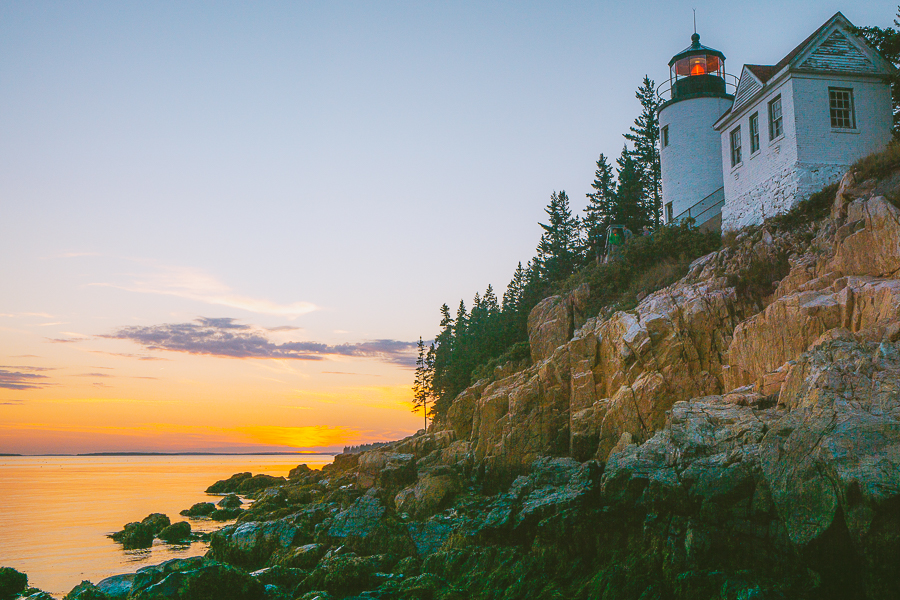
- Location: Maine, United States
- Established: 26 February 1919 by Woodrow Wilson
- How Many Days: 2-3 days
- Don’t Miss: Park Loop Road, Jordan Pond, Cadillac Mountain, Thunder Hole
- Best Time To Visit: September to early October (during the shoulder season)
Acadia is one of the United States’ most beloved national parks, particularly during the summer. Located on the coast of Maine, it welcomes more than three million travelers each year. Offering some of the most incredible drives, hikes, and walks, it’s no surprise that this is one of the East Coast’s top national parks.
Acadia covers more than 49,000 acres. This encompasses nearly half of Mount Desert Island, the Schoodic Peninsula, and a cluster of smaller islands.
The national park boasts a variety of unique landscapes, including woodlands, granite-domed mountains, lakes, and ponds. It also offers a picturesque ocean shoreline.
One of the best ways to experience the park’s many attractions is by driving along the scenic Park Loop Road. The trail begins at Hulls Cove Visitor Center and runs for 27-miles. It passes by Sand Beach, Thunder Hole, Jordan Pond, Otter Cliff, and Cadillac Mountain.
If possible, try to catch the sunrise or sunset from Cadillac Mountain. At 1530 feet, it is the highest point on the U.S. Atlantic coast.
Other great ways to experience Acadia’s beauty is by hiking, biking, or walking. There are a number of trails throughout the park. Two popular trails include Precipice Trail and Beehive Trail. Each of these is perfect for a fun day hike.
Acadia also offers some incredible camping opportunities. There are two campgrounds (Blackwoods and Seawall) on Mount Desert Island, one (Schoodic Woods) on the Schoodic Peninsula, and several more on Duck Harbor. During peak season, these can be booked up to six months in advance – so be sure to plan ahead.
Read More: 21 Fun Things To Do In Acadia National Park
Shenandoah National Park
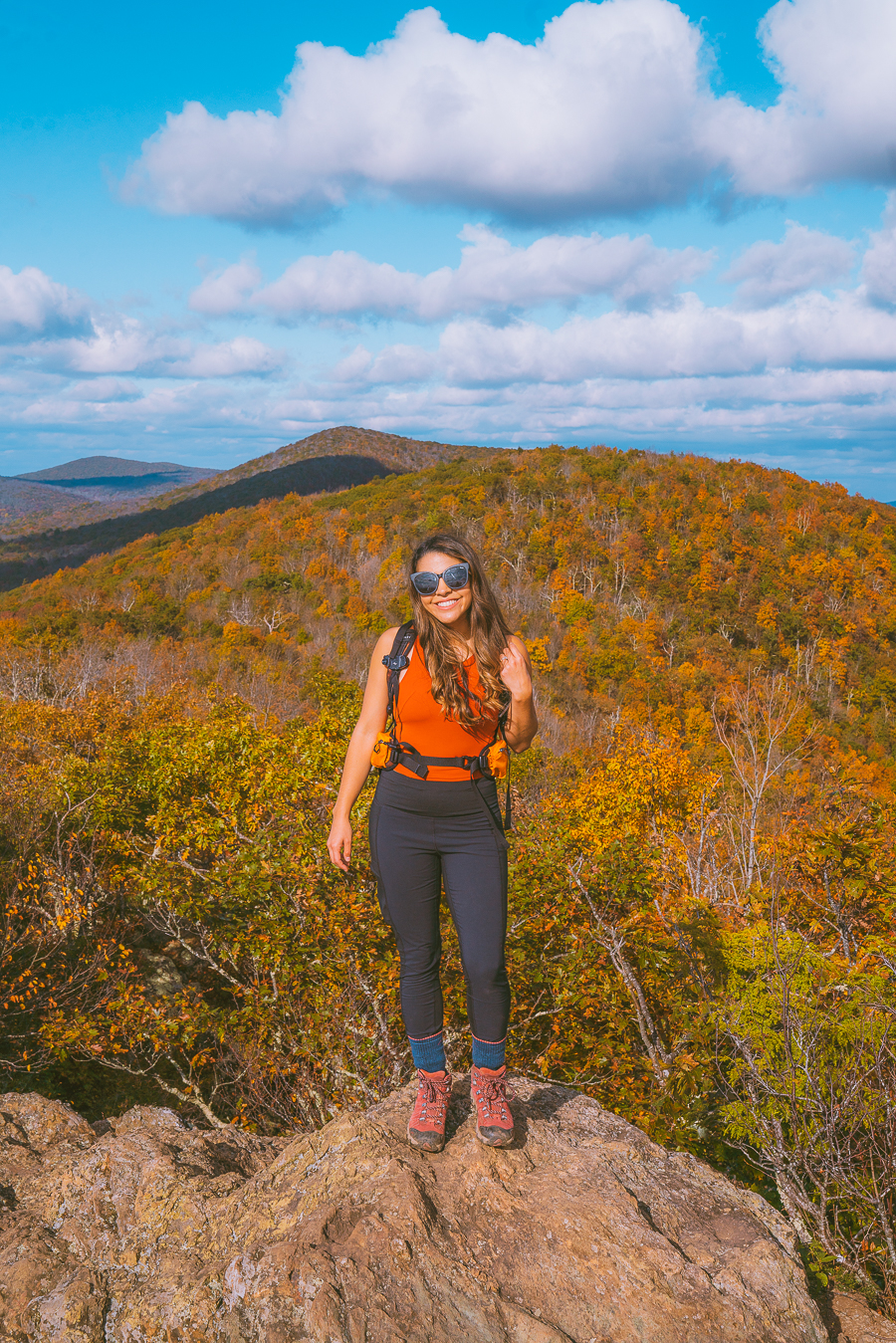
- Location: Virginia, United States
- Established: 26 December 1935
- How Many Days: 2-3 days
- Don’t Miss: Skyline Drive, Old Rag Mountain, Luray Caverns, Dark Hollow Falls
- Best Time To Visit: April to May (during spring)
Situated atop Virginia’s Appalachians is the breathtaking Shenandoah National Park. Each year, around 1.4 million individuals make their way to this 300-square-mile mountain jewel to explore its stunning landscapes.
Shenandoah is renowned for its incredible scenery. The national park boasts everything from grassy meadows to forested areas filled with hardwoods (hickory and oak) and conifers (pine). And scattered throughout is an abundance of wildlife, including deer, foxes, squirrels, bears, and various other mammals. It is also a wonderful spot for birdwatchers as the park is a magnet for migratory birds.
Shenandoah’s scenic beauty and various hidden treasures can all be discovered from the park’s famed Skyline Drive. This covers a distance of 105-miles, running the length of the park from north to south. The route has a strict speed limit of 35 mph. This way, you can take in incredible views of the park – particularly Blue Ridge Mountain and its surrounding scenery.
Shenandoah is also home to over 500-miles of trails, many of which ascend or descend from Skyline Drive. Some popular trails include Dark Hollow Falls (a 1.4-mile round trip) and Rose River Falls (a 2.6-mile round trip). These trails lead to some of the park’s most beautiful and refreshing waterfalls. You can also explore Shenandoah on horseback (tours can be arranged at Skyland Stables).
The national park is best experienced over a period of two to three days. And luckily, there is both camping and lodging available for overnight stays. Campgrounds include Mathews Arm, Big Meadows, Lewis Mountain, and Loft Mountain.
There are also two cozy lodges. So whether you choose to camp outdoors or lodge in a historical cabin, you’re guaranteed a comfortable stay in one of the U.S.’s most stunning national parks.
Read More: The 11 Best Hikes In Shenandoah National Park
Great Smoky Mountains National Park
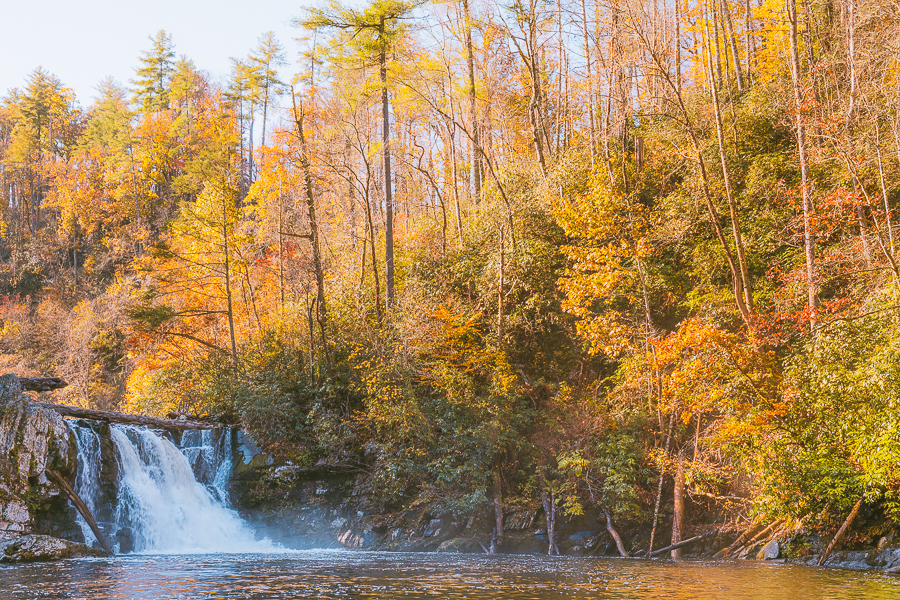
- Location: Between North Carolina and Tennessee, United States
- Established: 15 June 1934
- How Many Days: 4-5 days
- Don’t Miss: Cades Cove, Clingmans Dome, The Chimney Tops, Charlies Bunion
- Best Time To Visit: June to August (during the summer) or October (during fall)
With 14.1 million annual visitors, the Great Smoky Mountains is the most-visited national park in the United States. The park stretches over 500,000 acres, straddling on the border between North Carolina and Tennessee.
With its ancient mountains, cascading waterfalls, and diverse plant and animal life, it is a mecca for lovers of the outdoors. It is also one of the best parks to visit in the fall.
The Great Smoky Mountains National Park was dedicated in 1940 by President Franklin D. Roosevelt. He stated that the park is “for the permanent enjoyment of the people.” He also acknowledged the preservation of the ancient mountains. This is because the mountain is home to a wide variety of plants and wildlife – all of which have been undisturbed for millions of years.
The best way to experience the Great Smoky Mountains and all it has to offer is to do it on foot. After all, this is the way the land’s first settlers and explorers did it. The national park offers 800-miles of pristine backcountry, including everything from the original Appalachian Trail to scenic wildflower walks.
Trails also pass by the park’s 100-plus cascades and waterfalls. This includes Abrams, Grotto, Laurel, and Rainbow Falls.
If you’re not one for strenuous hikes, the park also boasts some incredibly scenic drives. Several routes travel from Gatlinburg towards various sections of unspoiled Appalachia. Along the way, pass by the national park’s top attractions – namely Newfound Gap, Clingman’s Dome, Mingus Mill, Oconaluftee Valley, and many more.
With so much to see, a trip to the Smoky Mountains can last anywhere between three and five days. When it comes to camping sites, you will find plenty throughout the park. Just note that backcountry camping requires a permit. And if you’re not much of a camper, there are also many rustic cabins, cottages, and vacation homes in the region.
Read More: The Best Great Smoky Mountain Hikes
Congaree National Park
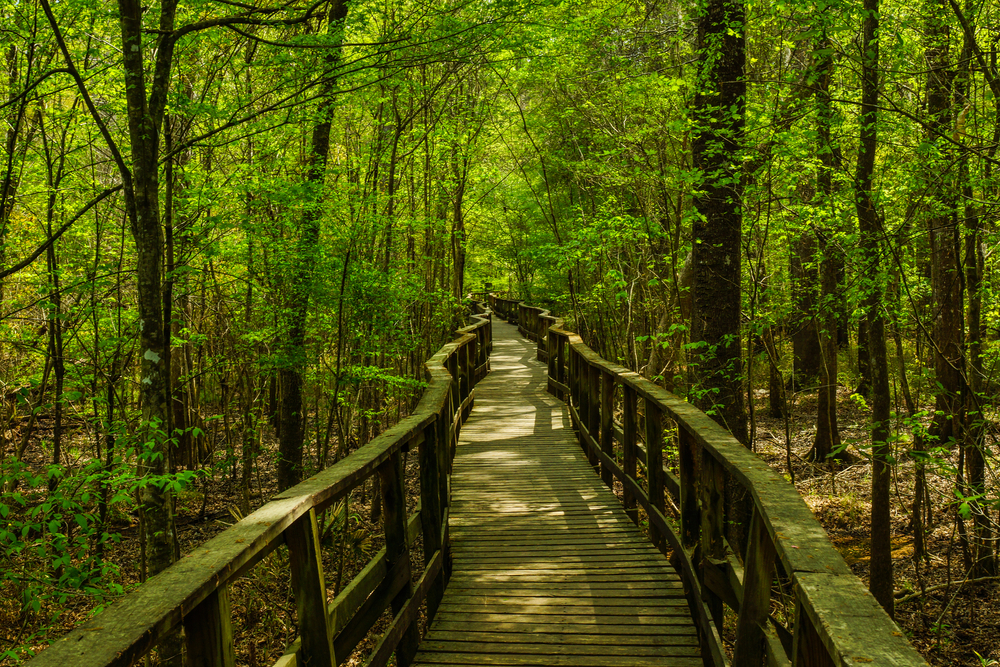
- Location: South Carolina, United States
- Established: 10 November 2003
- How Many Days: 1 day
- Don’t Miss: Boardwalk Loop Trail, Cedar Creek, Wise Lake, Fireflies, General Greene Tree
- Best Time To Visit: March to May (during spring)
While many national parks are renowned for their wide-spanning views and abundant wildlife, Congaree offers something different. Here you will find the largest contiguous tract of old-growth bottomland hardwood forest in the United States.
It is also home to some of the eastern region’s tallest trees. Each year, over one hundred thousand travelers visit the park to marvel at its biodiversity.
One of the best ways to experience the beauty of this ancient alluvial floodplain is from the many boardwalks that run through it. The Boardwalk Loop Trail is a popular 2.4-mile loop that traverses through the forest, passing by cypress, maple, oak, and tupelo trees. Other notable routes include Oakridge Trail, Weston Lake Loop Trail, and the 12-mile-long Kingsnake Trail.
You can also explore the park from the Congaree River. Make your way down the 15-mile-long Cedar Creek Canoe Trail with a kayak or canoe. This will take you through the park’s lush forest and enchanting wetlands.
Download my free Outdoor Photography Guide
Note: Visitors will need to bring their own equipment, including a kayak or canoe and a life jacket.
Another activity that the Congaree National Park is renowned for is fishing. It is permitted in almost all areas throughout the park. However, the best spots are along the Congaree River, Cedar Creek, and the oxbow lakes. Here you’re sure to come across plenty of striped basses. Just be sure to catch and release.
While most of the park can be explored in a day, there is camping available for those who wish to spend a night or two. Longleaf Campground sits near the park entrance and offers four group and ten individual camping sites. There are also several accommodations situated right outside Congaree.
Biscayne National Park
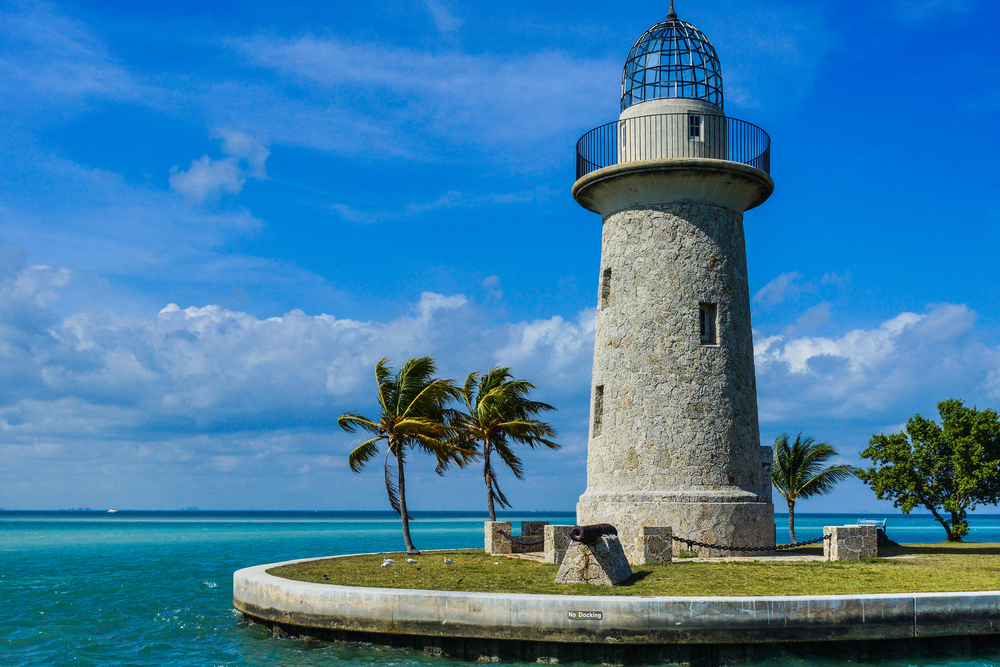
- Location: Florida, United States
- Established: 28 June 1980
- How Many Days: 1 day
- Don’t Miss: Boca Chita Key, Convoy Point Jetty Trail, Adams Key, Maritime Heritage Trail
- Best Time To Visit: November to May (outside of hurricane season)
Biscayne is another unique East Coast national park. While the word “park” is often associated with trees and greenery, Biscayne is 95% underwater.
The park stretches over 270 square miles southeast of Miami to the Florida Keys. Here you will find one of the world’s largest coral reefs, which is home to over 600 species of native fish. So for those seeking a fun aquatic adventure, this national park is a must.
Given that most of this national park sits underwater, it is best explored by boat. You can bring your own or rent a kayak or SUP at the park’s concession stand. With your boat, make your way across the clear, shallow waters and discover the reefs and islands of the national park. The park also offers a variety of paddling tours.
Biscayne is renowned for preserving and telling the stories of human history, which dates back 10,000 years. You’ll find evidence of native settlers on most of the islands, as well as the remains of various shipwrecks below the water’s surface. One of the best ways to discover the park’s many hidden treasures is on the Maritime Heritage Trail, which is accessible via scuba diving or snorkeling.
While there are many routes you can take by boat, there are several delightful nature trails, too. The Convoy Point Jetty Trail is a lovely 0.8-mile trail that you can do without needing a boat. If you’re able to make your way across the warm waters, the one-mile Elliott Key hiking trail is a good option.
Dry Tortugas National Park
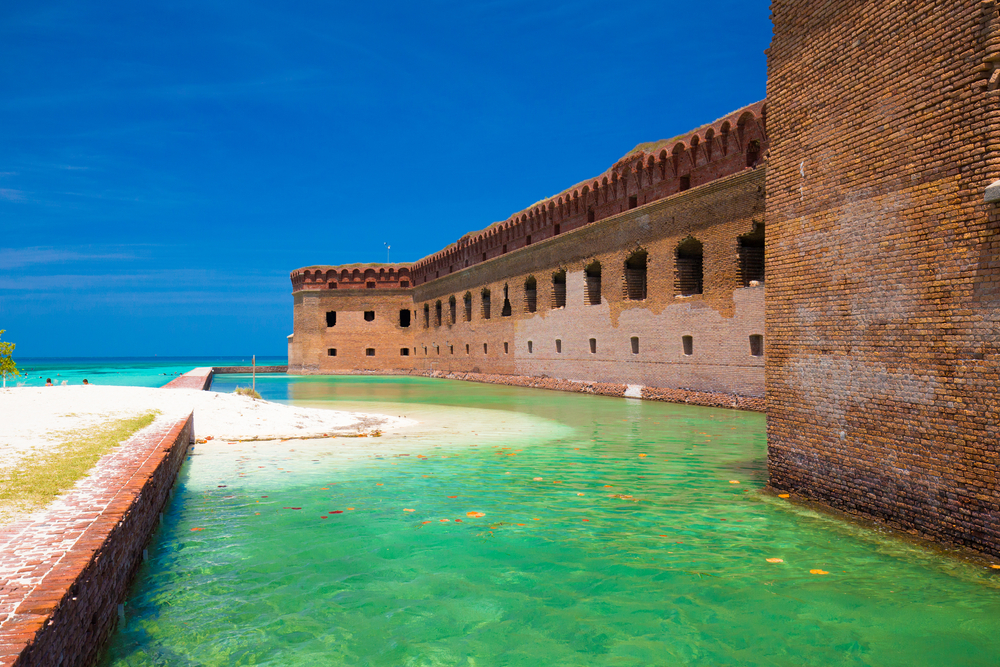
- Location: Florida, United States
- Established: 4 January 1935
- How Many Days: 1 day
- Don’t Miss: Fort Jefferson, Garden Key, Loggerhead Key
- Best Time To Visit: November to April
Another great national park that’s perfect for a day trip is Dry Tortugas. And like Biscayne, this Key West park offers over 100-square-miles of coral reef, marine life, and small islands.
Here, your adventure begins the moment you leave Key West. Take the ferry ride aboard Yankee Freedom to Dry Tortugas. The charter boat departs each morning at 8 am and returns around 5:15 pm. As such, you’ll have plenty of time to explore the park and all its natural wonders.
For a unique adventure, opt for a seaplane ride to Dry Tortugas. On this 45-minute flight, you’ll be spoiled with some of the most spectacular views of the national park, the marine life, and the many shipwrecks below the water’s surface.
Once you’ve arrived at Dry Tortugas, you’ll have plenty of options when it comes to activities. The first must-do activity is visiting Fort Jefferson. This is the largest brick building in the Western Hemisphere, covering an impressive 11 acres. You can explore the fort on a guided tour or on your own.
Another fun activity at Dry Tortugas is snorkeling. As you swim over the Florida Keys Reef System, keep your eyes open for the hundreds of marine species that occur here. This includes colorful coral and fish, sea turtles, lobster, and the park’s one lonely American crocodile. Snorkeling is often included in the various Fort Jefferson tours.
In addition to marine life, Dry Tortugas is a renowned birding destination. More than 300 bird species have been identified at this national park, including Frigatebirds, Sooty Terns, and the rare Black Noddy. Even for those who aren’t avid birders, the abundant birdlife found here is a sight to behold.
Everglades National Park
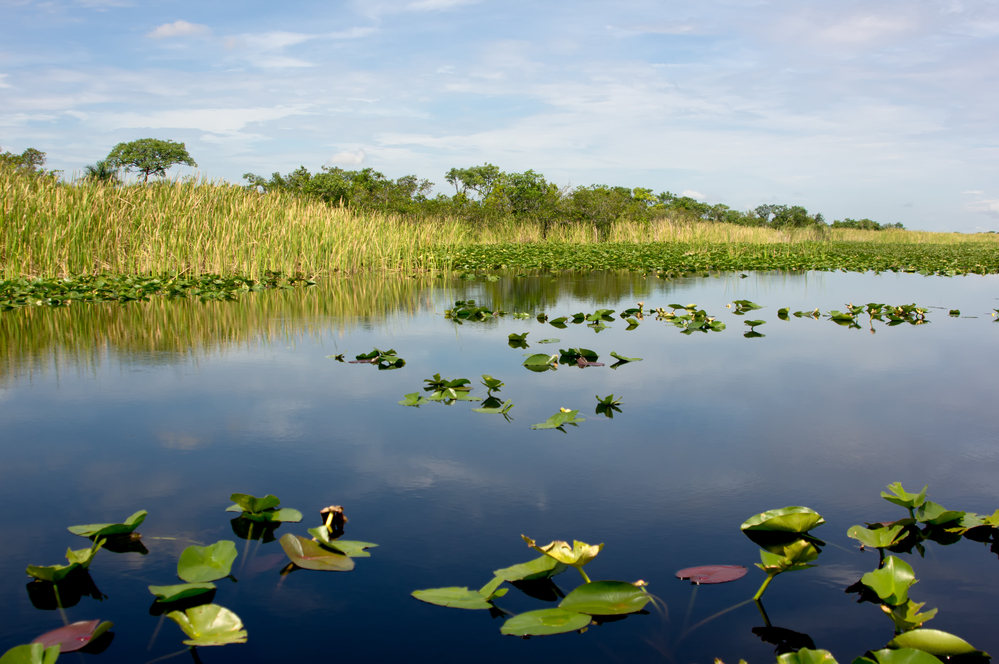
- Location: Florida, United States
- Established: 6 December 1947
- How Many Days: 2-3 days
- Don’t Miss: Anhinga Trail, Airboats, Ten Thousand Islands
- Best Time To Visit: December to April (during the dry season)
No trip to Florida is complete without stopping at Everglades National Park. Each year, more than one million people from all over the world visit the park to marvel at its 1.5 million acres of tropical and subtropical habitat. This mysterious swampland comprises one of the world’s most diverse ecosystems and is one of the best parks to visit in winter.
Everglades National Park is home to a wide range of animals, including deer, manatees, snakes, panthers, and various bird species. However, the animal the park is most renowned for is the American crocodile. You may encounter these incredible creatures when venturing through the Florida mangroves and swamps.
One of the best ways to explore the national park is on a ranger-guided canoe tour. This is great as you’ll be able to learn more about the swamplands and the animals that inhabit them. Other popular ways to experience the area include slogging or an Airboat ride.
In addition to the swamplands, you can also take a kayak to visit the Ten Thousands Island or travel by boat along the Gulf of Mexico. Here you will be able to see a different selection of wildlife than you might have found in the wetlands. This includes dolphins, sea turtles, and an array of shorebirds.
Everglades is the third-largest national park in the lower 48 states. For this reason, you’ll want to spend two-to-three days to take it all in. To see you through your stay is the Flamingo Lodge. However, for those looking to rough it out, there are several campgrounds located throughout the park.
Grab Your Free Car Camping Checklist! 🚗🌲
Ready to elevate your car camping game? Snag our essential checklist to ensure you’ve got everything you need for a stress-free, fun-filled adventure! Perfect for beginners and seasoned campers alike. Download now and hit the road prepared! 🌟🎒
New River Gorge National Park
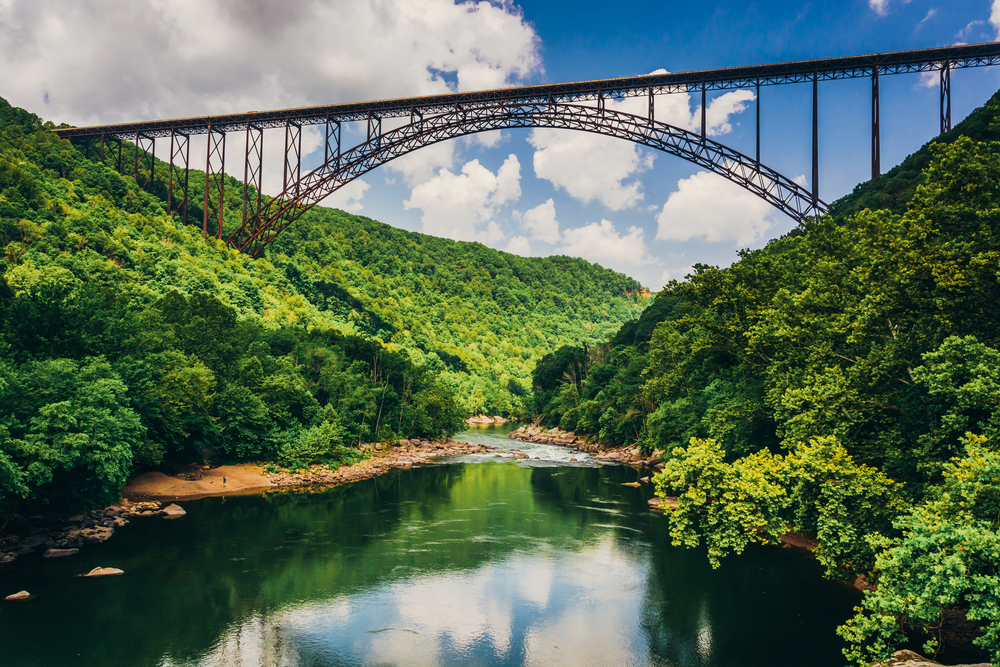
- Location: West Virginia, United States
- Established: 10 November 1978
- How Many Days: 3 days
- Don’t Miss: Canyon Rim Visitor Center, New River Gorge Bridge, Grandview
- Best Time To Visit: April to October (during the warmer seasons)
New River Gorge is the most recently declared national park in the United States. Here, 73,000 acres of rugged canyon and whitewater rapids offer some of the best rock climbing and whitewater rafting opportunities. So it’s no surprise that this destination is a favorite amongst outdoor enthusiasts.
While New River Gorge was only declared a national park in recent years, the iconic river dates back millions of years. Some estimates even suggest that the river is 360 million years old. This would make it older than the Colorado River, the Meuse, the Finke, and even the Nile River.
New River Gorge also boasts a long human history, featuring coal mines and railroad tycoons. There are a number of places throughout the park where you can learn the history of New River Gorge. This includes the Sandstone Visitor Center, the Thurmond Historic District, the mining town of Nuttallburg, and several more.
You’re also sure to learn a thing or two while venturing through the park. A great way to explore New River Gorge is by hiking, and there are nearly 100-miles of trails to choose from. The most popular routes are the Endless Wall Trail, Long Point Trail, and Grandview Rim Trail. You can also hit the trails on a mountain bike.
In addition to its hiking, rock climbing, Class IV-plus whitewater rafting opportunities, the park is a popular spot for camping. With so much to explore, you will need to spend a minimum of three days here. Luckily, there is a wide variety of camping areas throughout the park. Almost all of these provide easy access to the river – perfect for fishing or boating.
Mammoth Cave National Park
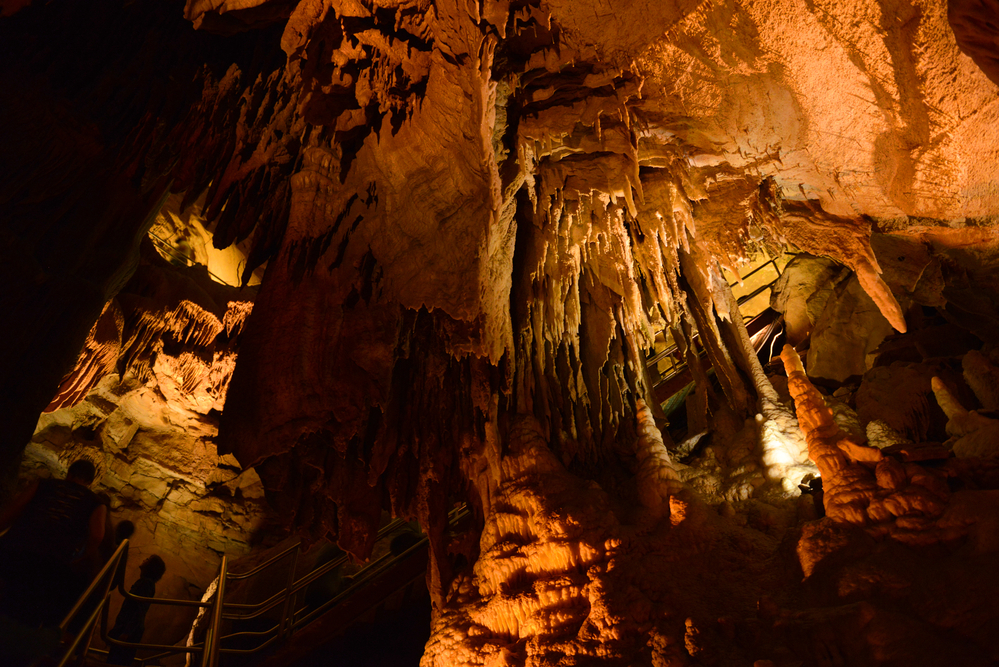
- Location: Commonwealth of Kentucky, United States
- Established: 1 July 1941
- How Many Days: 2-3 days
- Don’t Miss: Frozen Niagara, Sloan’s Crossing Pond, Green River Ferry, River Styx Spring
- Best Time To Visit: November to February (during winter)
With over 400-miles of caves and passageways, Mammoth Cave is the longest cave system in the world. There’s something truly magical about descending into this mysterious subterranean world. Here, you can explore the canyons and passageways that humans have wandered for more than 4,000 years.
To help you discover the cave’s many secrets are a variety of guided tours. These cover different sections of the cave, passing by various rock formations and underground rivers.
One of the most popular tours is the Historic tour. On this two-hour tour, traverse through the many passageways while learning about the cave’s history. You’ll come across various landmarks, including Mammoth Dome, the Bottomless Pit, and the old saltpeter mines.
The Frozen Niagara tour is also a must for anyone visiting Mammoth Cave. This tour highlights the many decorative formations found in Frozen Niagara and the Drapery Room. These attractions can also be reached on the Domes and Dripstones tour. The difference is that you get to travel deeper into the cave, so you’ll come across a number of other dramatic cave features.
Mammoth Cave National Park offers plenty more to do apart from the many cave tours. For starters, there are several scenic walking trails for visitors to enjoy. A favorite is the Heritage Trail. Follow the flat 0.5-mile-long trail towards Sunset Viewpoint, where you’ll be met with incredible views over the park’s hilly landscape. Other points of interest include the beautiful Green River and the enchanting River Styx Spring.
With the many tours and trails waiting to be explored, it is recommended that you spend at least two-to-three days here. To see you through your stay is The Lodge at Mammoth Park. Alternatively, you can take a short drive to Cave City. Here you’ll find a variety of accommodation options such as the Sleep Inn & Suites, as well as restaurants.
Cuyahoga Valley National Park
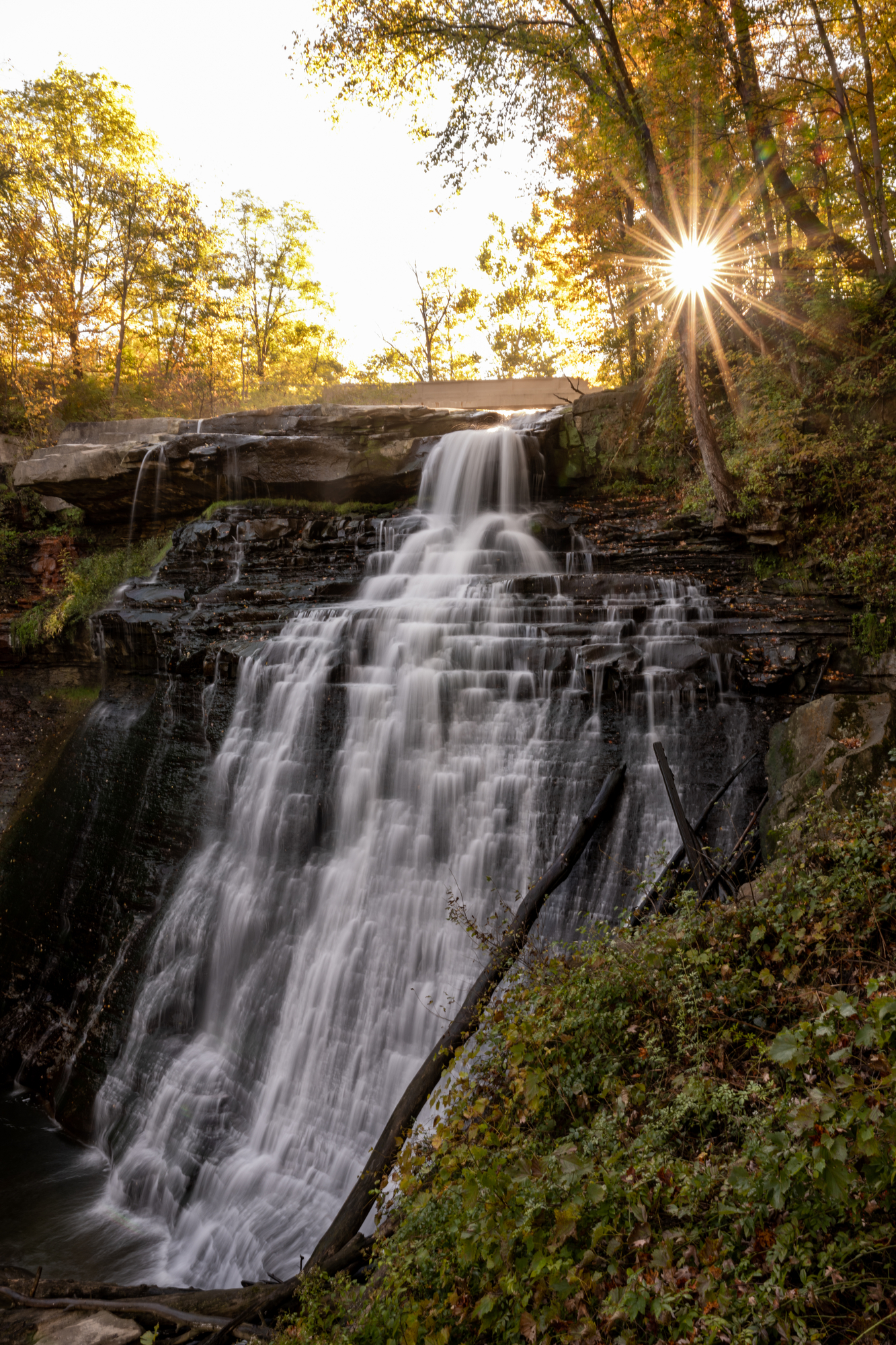
- Location: Ohio, United States
- Established: 27 December 1974
- How Many Days: 1-2 days
- Don’t Miss: Blue Hen Falls, The Ledges Trail, Brandywine Falls, Beaver Marsh
- Best Time To Visit: September to October (during fall) or April to May (during spring)
Providing a scenic reprieve from the surrounding urban jungle is Cuyahoga Valley National Park. Locals often refer to it as “Urban National Park” as it sits surrounded by urban neighborhoods. Interstate highways and roads pass through the park, dividing it into different sections.
While it has an urban element to it, the heart of this park is the valley and Cuyahoga River. Here you will find acres and acres of nature, wildlife, and outdoor recreation opportunities.
When visiting Cuyahoga, your first stop is often the Boston Mill Visitor Center. The white building once served as a general store for the old canal town. Today, it is the park’s only visitor center and features a small gift shop. With brochures and park maps on hand and rangers waiting to assist, this is also the perfect place to start planning your Cuyahoga trip.
From here, there are a number of areas in the park that you can visit. A popular stop is the Canal Exploring Center. This is a charming museum that explores the history of the Ohio Erie Canal. For a further look into the area’s past, take a tour of the Hale Farm and Village or charming Everett Covered Bridge.
Cuyahoga is also famous for its incredible hiking and biking trails. Take the moss-covered Ledges Trail and hike along the base of the park’s dramatic sandstone cliffs. Or, tackle one of the trails that lead to the park’s famous waterfalls – namely Blue Hen Falls and Brandywine Falls. Each route is relatively easy and passes through some of the most scenic areas in the Cuyahoga Valley.
Another beautiful stop worth including in your Cuyahoga itinerary is Beaver Marsh. This is a naturally diverse wetland and is home to a variety of animals, such as birds, ducks, snakes, turtles, and of course, beavers.
Isle Royale National Park
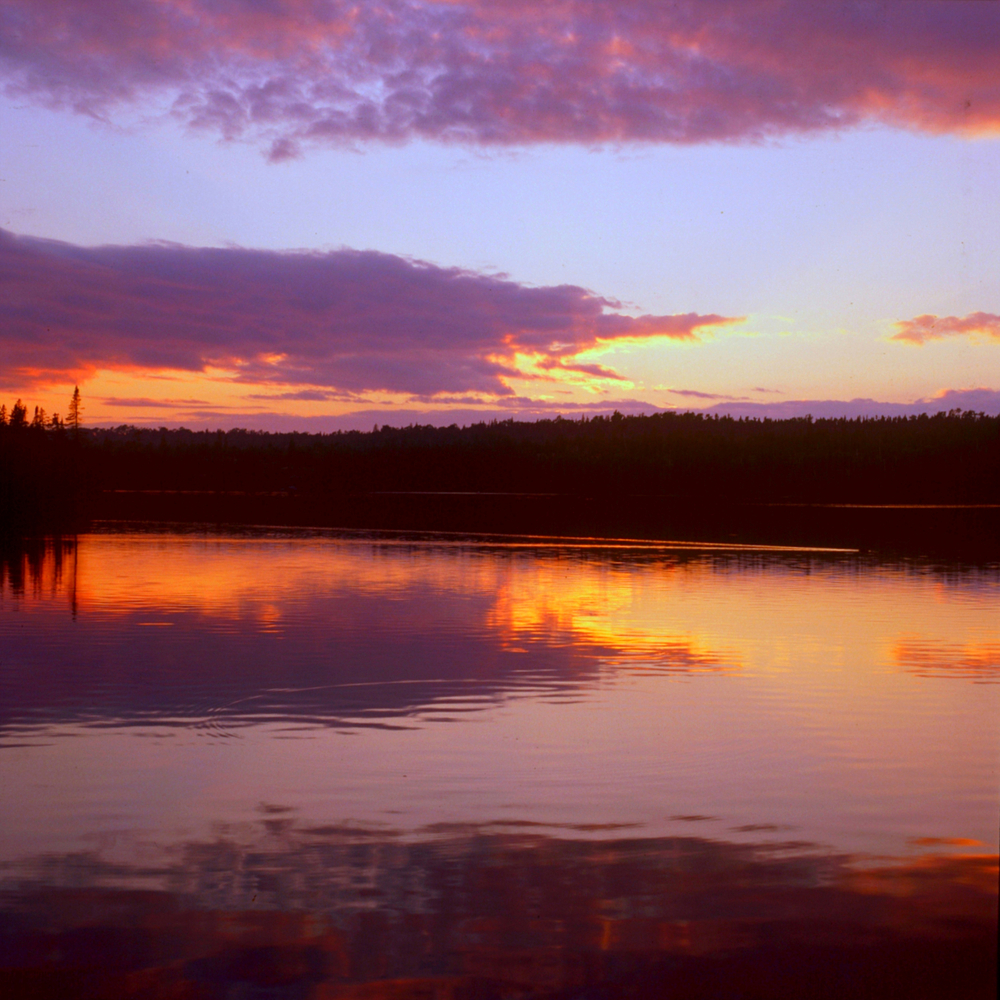
- Location: Northwestern Michigan, United States
- Established: 3 April 1940
- How Many Days: 3-5 days
- Don’t Miss: Lake Superior, Rock Harbor, Scoville Point, Windigo Visitor Center
- Best Time To Visit: May, June, and September as the weather is cooler
Isle Royale is a small island in the middle of the famed Lake Superior and is one of Michigan’s five national parks. Thousands of people visit each year to view the diverse plant and animal life and to seek adventure. After all, the park offers an endless list of things to do, starting with an unforgettable boat ride to the island.
Depending on the boat you take, and where you depart from, the journey could last anywhere between three to six hours. Boat options include the Ranger III from Houghton, the Isle Royale Queen IV from Copper Harbor, and several more. Along the way, enjoy spectacular views of the beautiful lake and the surrounding wilderness.
On the island, plenty of adventures awaits you. One of the best activities here is hiking. While there are many trails traversing throughout, the best is undoubtedly the Greenstone Ridge Trail. The popular national park hike begins at Lookout Louise and heads west, passing by Greenstone’s exposed ridges, deep forests, wetlands, and lakes.
Note: This 43-mile hike is not for the fainthearted as it takes around three-to-five days to complete.
There are also several smaller adventures on the island. A favorite amongst those who visit is touring the lighthouses. Isle Royale is home to three lighthouses – Rock Harbor, Menagerie Island, and Passage Island. The most famous of these landmarks is the Rock Harbor lighthouse, which stands as a testament to the island’s once-thriving mining era.
While you’re here, you should also take time to explore the waters surrounding the island. Lake Superior features a number of old shipwrecks. If you’re feeling brave, go scuba diving and explore the world below.
For those who plan on spending multiple days at the national park, there are a number of camping and lodging options available. There are 36 campgrounds stretched out between the Lake Superior shoreline and the backcountry, as well as the Rock Harbor Lodge and Windigo Camper Cabins. All of these guarantee a comfortable stay.
Hot Springs National Park

- Location: Arkansas, United States
- Established: 20 April 1832
- How Many Days: 3 days
- Don’t Miss: Buckstaff Bathhouse, Fordyce Bathhouse, Sunset Trail
- Best Time To Visit: August to October
If you’re seeking a combination of relaxation and adventure, then Hot Springs may be the perfect destination for you. Here you will find a national park devoted almost entirely to hot springs.
Throughout this urban national park are clusters of geothermal pools that date back more than 4,000 years. Today, visitors can still soak in the healing waters at the various historical establishments that line Bathhouse Row.
The two most popular establishments are the Fordyce Bathhouse and Buckstaff Bathhouse. Fordyce Bathhouse is the largest bathhouse and serves as the national park’s Visitors Center, as well as a museum. Here you can enjoy a guided tour of the building and marvel at its beautiful marble interiors and stained glass windows while learning about the park’s history.
While the hot springs are the park’s biggest draws, there are also plenty of opportunities for adventure. The national park is home to 30-miles of hiking trails that explore the Ouachita Mountains.
The most notable route is the Sunset Trail, which snakes 10-miles through the park, ending at the West Mountain Summit. Other favorites include the Goat Rock Trail and Gulpha Gorge Trail.
There are also various other attractions worth visiting, including the Garvan Woodlands Gardens, the Grand Promenade, and Hot Springs Mountain Tower. With so much to see and do, you will need at least three days here.
For overnight stays, choose between camping and lodging. Gulpha Gorge is the park’s only campground, while the downtown area and Bathhouse Row offer a variety of hotels.
Which East Coast National Park Will You Be Visiting?
The East Coast is home to some of the most incredible national parks in the United States. This includes everything from scenic parks that explore the Appalachian Mountains to parks that are almost completely underwater. So no matter what type of adventure you’re seeking, there’s something for everyone.
Do you want to tackle more than one of these destinations? Check out this guide on how to plan the perfect USA national park road trip.

